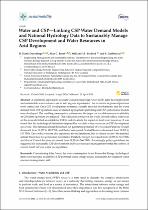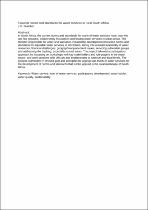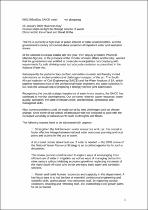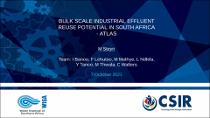 ResearchSpace
ResearchSpace
Water and CSP—Linking CSP water demand models and national hydrology data to sustainably manage CSP development and water resources in arid regions
JavaScript is disabled for your browser. Some features of this site may not work without it.
- ResearchSpace
- →
- Research Publications/Outputs
- →
- Journal Articles
- →
- View Item
| dc.contributor.author |
Duvenhage, F

|
|
| dc.contributor.author |
Brent, AC

|
|
| dc.contributor.author |
Stafford, William HL

|
|
| dc.contributor.author |
Grobbelaar, S

|
|
| dc.date.accessioned | 2021-02-26T12:39:38Z | |
| dc.date.available | 2021-02-26T12:39:38Z | |
| dc.date.issued | 2020-04 | |
| dc.identifier.citation | Duvenhage, F., Brent, A., Stafford, W.H. & Grobbelaar, S. 2020. Water and CSP—Linking CSP water demand models and national hydrology data to sustainably manage CSP development and water resources in arid regions. <i>Sustainability, 12(8).</i> http://hdl.handle.net/10204/11806 | en_ZA |
| dc.identifier.issn | 2071-1050 | |
| dc.identifier.uri | http://hdl.handle.net/10204/11806 | |
| dc.description.abstract | A systematic approach to evaluate Concentrating Solar Power (CSP) plant fleet deployment and sustainable water resource use in arid regions is presented. An overview is given of previous work carried out. Once CSP development scenarios, suitable areas for development, and the water demand from CSP operations were evaluated, appropriate spatiotemporal CSP performance models were developed. The resulting consumptive patterns and the impact of variable resource availability on CSP plant operation are analysed. This evaluation considered the whole of South Africa, with focus on the areas identified as suitable for CSP, in order to study the impact on local water resources. It was found that the hydrological limitations imposed by variable water resources on CSP development are severe. The national annual theoretical net generation potential of wet-cooled Parabolic Trough decreased from 11,277 to 120 TWh, and that of wet-cooled Central Receiver decreased from 12,003 to 170 TWh. Dry cooled versions also experience severe limitations, but to a lesser extent—the national annual theoretical net generation potential of Parabolic Trough decreased from 11,038 to 512 TWh, and that of Central Receiver decreased from 11,824 to 566 TWh. Accordingly, policy guidelines are suggested for sustainable CSP development and water resource management within the context of current South African water use regulation. | en_US |
| dc.format | Fulltext | en_US |
| dc.language.iso | en | en_US |
| dc.relation.uri | doi:10.3390/su12083373 | en_US |
| dc.relation.uri | https://www.mdpi.com/2071-1050/12/8/3373 | en_US |
| dc.source | Sustainability, 12(8) | en_US |
| dc.subject | Concentrating solar power | en_US |
| dc.subject | Water consumption factors | en_US |
| dc.subject | Renewable energy | en_US |
| dc.subject | Hydrological limits | en_US |
| dc.subject | Hydrological limits | en_US |
| dc.subject | Water resource availability | en_US |
| dc.subject | Concentrating solar power | en_US |
| dc.subject | Concentrating solar power | en_US |
| dc.subject | CSP | en_US |
| dc.subject | CSP potential | en_US |
| dc.subject | Water–energy nexus | en_US |
| dc.subject | Sustainable development | en_US |
| dc.subject | Water resource management | en_US |
| dc.subject | Arid | en_US |
| dc.title | Water and CSP—Linking CSP water demand models and national hydrology data to sustainably manage CSP development and water resources in arid regions | en_US |
| dc.type | Article | en_US |
| dc.description.pages | 32 | en_US |
| dc.description.note | © 2020 The authors. Licensee MDPI, Basel, Switzerland. This article is an open access article distributed under the terms and conditions of the Creative Commons Attribution (CC BY) license (http://creativecommons.org/licenses/by/4.0/). | en_US |
| dc.description.cluster | Smart Places | en_US |
| dc.description.impactarea | Waste Benefication | en_US |
| dc.identifier.apacitation | Duvenhage, F., Brent, A., Stafford, W. H., & Grobbelaar, S. (2020). Water and CSP—Linking CSP water demand models and national hydrology data to sustainably manage CSP development and water resources in arid regions. <i>Sustainability, 12(8)</i>, http://hdl.handle.net/10204/11806 | en_ZA |
| dc.identifier.chicagocitation | Duvenhage, F, AC Brent, William HL Stafford, and S Grobbelaar "Water and CSP—Linking CSP water demand models and national hydrology data to sustainably manage CSP development and water resources in arid regions." <i>Sustainability, 12(8)</i> (2020) http://hdl.handle.net/10204/11806 | en_ZA |
| dc.identifier.vancouvercitation | Duvenhage F, Brent A, Stafford WH, Grobbelaar S. Water and CSP—Linking CSP water demand models and national hydrology data to sustainably manage CSP development and water resources in arid regions. Sustainability, 12(8). 2020; http://hdl.handle.net/10204/11806. | en_ZA |
| dc.identifier.ris | TY - Article AU - Duvenhage, F AU - Brent, AC AU - Stafford, William HL AU - Grobbelaar, S AB - A systematic approach to evaluate Concentrating Solar Power (CSP) plant fleet deployment and sustainable water resource use in arid regions is presented. An overview is given of previous work carried out. Once CSP development scenarios, suitable areas for development, and the water demand from CSP operations were evaluated, appropriate spatiotemporal CSP performance models were developed. The resulting consumptive patterns and the impact of variable resource availability on CSP plant operation are analysed. This evaluation considered the whole of South Africa, with focus on the areas identified as suitable for CSP, in order to study the impact on local water resources. It was found that the hydrological limitations imposed by variable water resources on CSP development are severe. The national annual theoretical net generation potential of wet-cooled Parabolic Trough decreased from 11,277 to 120 TWh, and that of wet-cooled Central Receiver decreased from 12,003 to 170 TWh. Dry cooled versions also experience severe limitations, but to a lesser extent—the national annual theoretical net generation potential of Parabolic Trough decreased from 11,038 to 512 TWh, and that of Central Receiver decreased from 11,824 to 566 TWh. Accordingly, policy guidelines are suggested for sustainable CSP development and water resource management within the context of current South African water use regulation. DA - 2020-04 DB - ResearchSpace DP - CSIR J1 - Sustainability, 12(8) KW - Concentrating solar power KW - Water consumption factors KW - Renewable energy KW - Hydrological limits KW - Hydrological limits KW - Water resource availability KW - Concentrating solar power KW - Concentrating solar power KW - CSP KW - CSP potential KW - Water–energy nexus KW - Sustainable development KW - Water resource management KW - Arid LK - https://researchspace.csir.co.za PY - 2020 SM - 2071-1050 T1 - Water and CSP—Linking CSP water demand models and national hydrology data to sustainably manage CSP development and water resources in arid regions TI - Water and CSP—Linking CSP water demand models and national hydrology data to sustainably manage CSP development and water resources in arid regions UR - http://hdl.handle.net/10204/11806 ER - | en_ZA |
| dc.identifier.worklist | 24079 | en_US |








